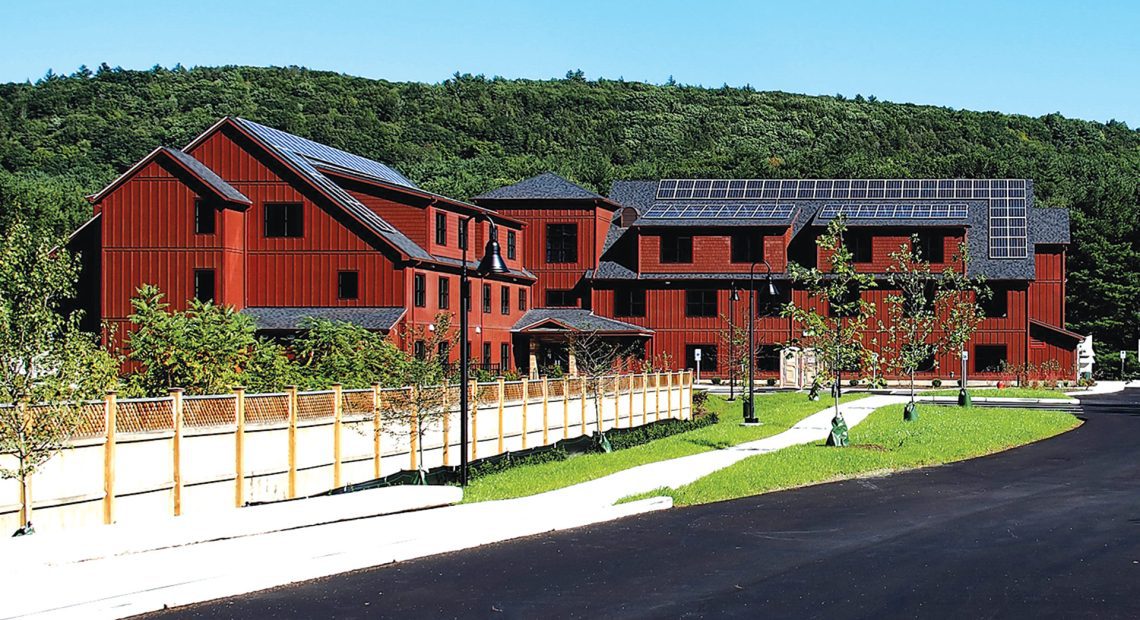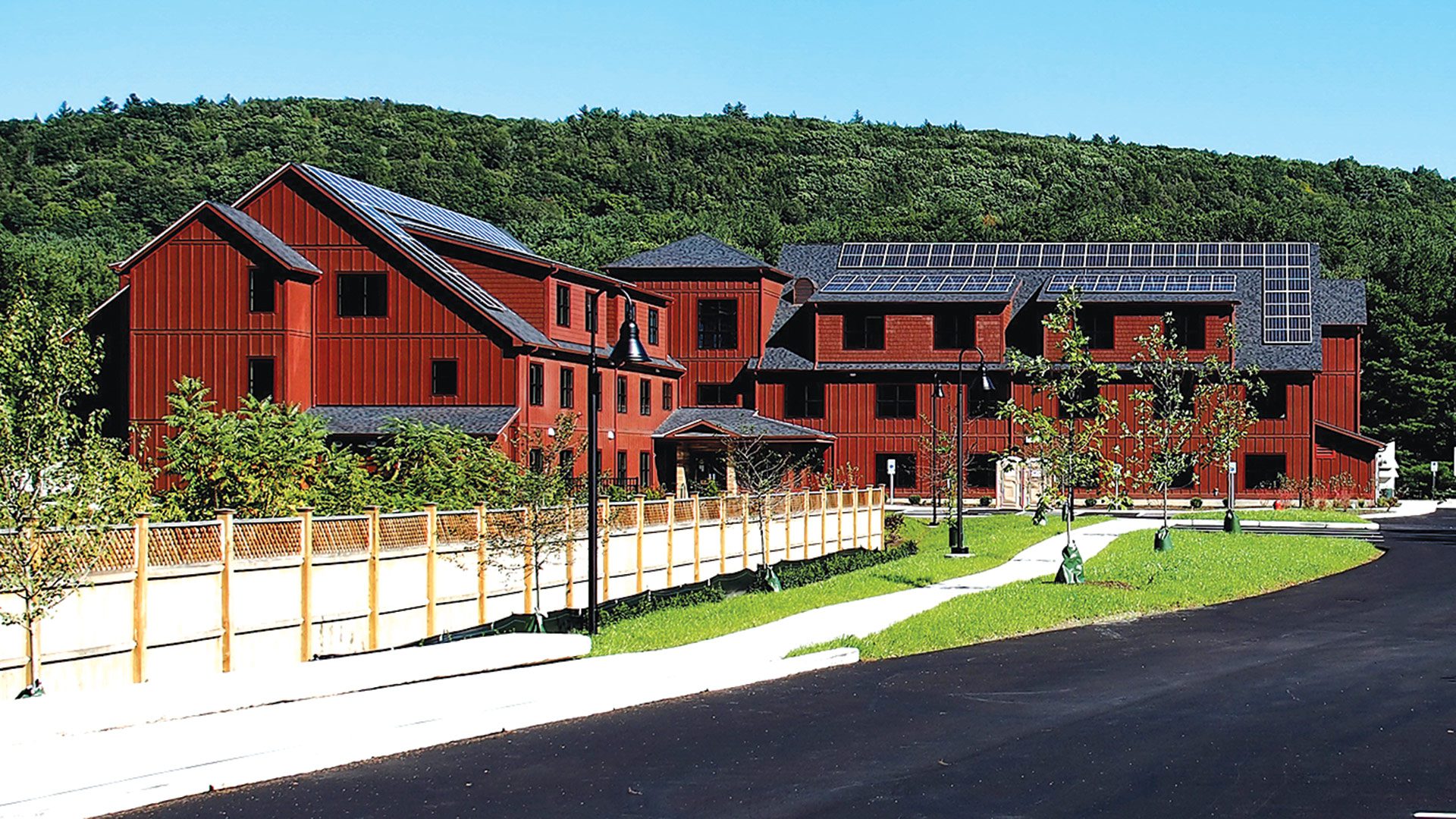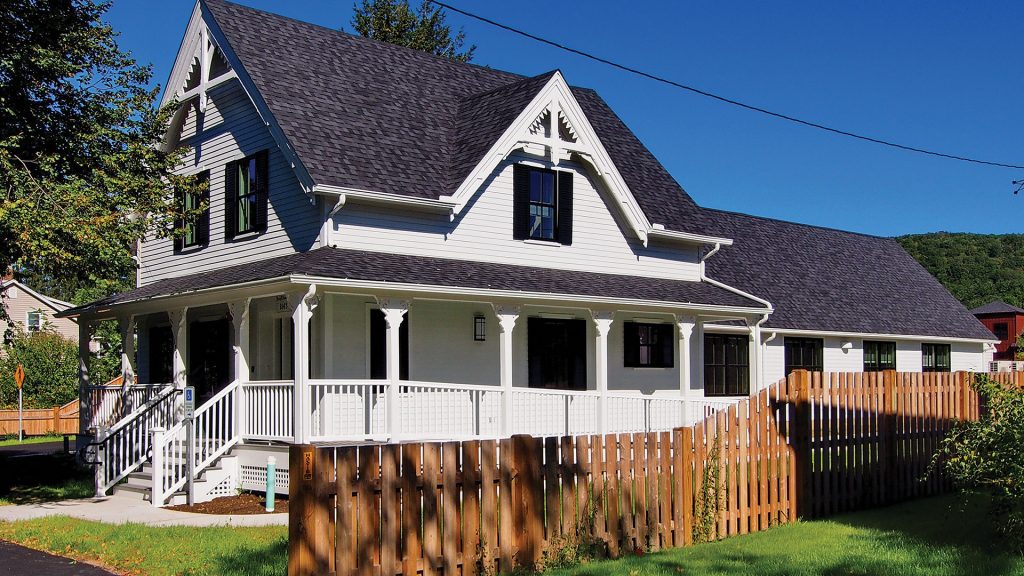
Marois Construction Builds on a Strong Foundation
Setting Their Sites


Marois Construction recently converted this single-family farmhouse built around 1860 into a three-story, 30-unit housing complex (top).
Construction is a lot like the mail. Projects have to be delivered on time, regardless of the weather.
And to say it’s been a rainy year is an undertstatement.
“Weather is a common occurrence in the construction industry. And, depending on what we have going on at any particular time, we typically have to continue operations, as long as it’s not a total washout,” said Carl Mercieri, vice president of Marois Construction in South Hadley.
On one day of downpours in mid-September, he recalled, “our crews were in the field. They were tying rebar for footings for a project they were doing for the Chicopee Water Department. They braved the weather and set up some collapsible canopies.
“Our project schedules don’t take weather into consideration. So we’ve got to complete them,” Mercieri added. “And not only that, but the crews doing that job need to move on to another job. So we do the best we can with what we got to work with. And, you know, I’ve been doing this for over 40 years, and the weather is not changing here in New England.”
But plenty else has changed in construction over the past 50 years, and Marois Construction — founded by company President Joe Marois in 1972 — celebrated that half-century milestone last year. Those changes run the gamut from new technology to cutting-edge materials to modern priorities in the building world, especially around green, energy-efficient building.
Through all of it, Marois has steadily built a solid reputation, and its current workload reflects that.
“Backing up a year, 2022 was a stellar year, and in 2023, we got off to the same start,” Mercieri said “Every year is a little bit different, though. This year has been a bit quirky. We’ve had a lot on our books, but for one reason or another, we’ve had some projects that got delayed.
“And then, of course, summer is our busy season, with all the college and school work. So we were working six days a week. Typically, when September rolls around, we start to slow down, and things get back to normal,” he went on. “But when those projects that actually got started got delayed, they all came to life in September. So we’re not seeing any slowdown here, looking at the third quarter and toward the end of the year. So it looks like it’s going to be another really good year for us.”
Broad Range of Expertise
Marois performs both public and private work, both new construction and renovations, across a range of sectors, including commercial, industrial, and educational projects, Mercieri said.
“Right now we’re doing a branch bank … we’ve got a couple of schools that we’re doing, kitchen renovations in schools. We’re also building a police department for one of the local municipalities.”
Carl Mercieri
“I’d say probably 70% of the guys in the workforce are closer to retirement age than not. So it’s extremely important that we get some of the younger people in.”
This diversity can be a positive in an uncertain economy.
“With all the ARPA money out there, there’s a lot of school work going in the public sector,” he added. “And we’re seeing a trend toward the private schools and charter schools. We’ve got one that we’re working on right now out in Stockbridge.”
In the post-pandemic world, contractors have been faced with a number of challenges all at once, from the impact of inflation to supply shortages. Mercieri said those trends are starting to subside, but not as quickly as most would like.
“We continue to see issues. There seems to be longer lead times on products,” he noted, citing doors and windows as examples. “A few years ago, before COVID, we could call in an order in the morning for hollow metal door frames and have them by in the afternoon. Now, we’re seeing a lead time of several weeks, which really impacts the schedule.
“For a while there, lumber was scarce, but lumber seems to have rebounded,” he added. “Prices have come down somewhat, but they really didn’t get back to where they were.”
And when supplies and equipment are difficult to procure or beset by delays, “it keeps the project going. You can’t close it out, even though it’s substantially complete. So one of the things that we deal with is that, going into a project, you can anticipate these delays, but you really can’t put a finger on how long the delays are going to be; it really depends on the manufacturer’s production line and what they’re doing.”
In one case this year, involving a generator, he was given a delivery date of April, and a week or two before it was supposed to ship, the date was pushed to June, then it was pushed again to August.
“We ended up getting it the first or second week of September,” he went on. “So you have no control over that, and it’s an unfortunate situation. And we don’t know where the problem lies; we don’t know if it’s a matter of materials on the manufacturer’s end or labor or a combination of both. But it has a pretty big impact on the construction industry, for sure.”
So has a persistent workforce shortage, one that has affected many industries lately. “It’s tough, but that’s been a trending issue over the years; I don’t think that’s anything new in this industry,” Mercieri said.
“Ninety percent of it is showing up every day; 10% is paying attention and learning.”
“So … we’ve adapted,” he went on. “We run our crews a bit leaner, meaning when we set up a job, rather than having a large crew over there, we’ll set up a smaller core crew at each job. And then, as a task comes up, we’ll move people around to the job and build up the crew, get them in, get them out, and then move them on to another job.”
The leadership team at Marois is certainly not alone in noting the need for more young talent in the pipeline.
“I go to these job sites, and I see our own crew, or I see our subcontractors, and … some of these guys I’ve known for 35 years,” he told BusinessWest. “I’d say probably 70% of the guys in the workforce are closer to retirement age than not. So it’s extremely important that we get some of the younger people in.”
He said the industry has been hurt over the past couple decades by a prevalent message that young people need to go to college to be successful. In fact, Massachusetts ranks among the top states in sending high-school graduates to college. At the same time, industrial-arts programs have been cut from public-school curricula, due to liability, budget cuts, or other factors, Mercieri noted.
But there is a pitch to be made, at a time when families are growing more concerned with crushing debt coming out of college, that careers in construction are attainable, with a clear path to growth, without much, if any, debt.
“Ninety percent of it is showing up every day; 10% is paying attention and learning,” he said, citing the example of someone who wants to specialize in carpentry but might not have the skills for a specific niche right off the bat. “There are multiple facets in carpentry. And you may be better at one or the other. Maybe you’re good at rough carpentry, and maybe you’re not as good at finished carpentry. But over time, you’re going to be very experienced — and you’ll probably be good at both.”
From the Ground Up
Mercieri knows what he’s talking about; he fell into construction at a young age, doing work for a friend’s father who owned a construction business.
“Basically, I was the young kid, and I got to carry all the tools for the tradespeople. I learned the electrical trade, plumbing, carpentry. I got my hands and feet wet being a helper. Then, over the years, it kind of grew on me, and the rest is history.”
He’s been in the field long enough to experience the transition from bid requests via phone calls and snail mail to digital platforms.
“And you think about the field now. Back then, there were no cell phones; there were no iPads. If something came up, a guy would run to a phone booth, or we’d set up landlines with a trailer, and they’d be calling the office. Now our guys in the field have iPads; as soon as we receive something here in the office, it goes right upstream, and they receive it out in the field.”
It’s just one of many changes Mercieri has seen over his decades in construction. And with one more year almost in the books, he’s feeling optimistic about 2024.
“We’ve got a fair amount on the books,” he told BusinessWest. “Some of the jobs that we’re doing now will run into 2024. The bidding market seems very strong. So we think we’re going to do pretty well.”






